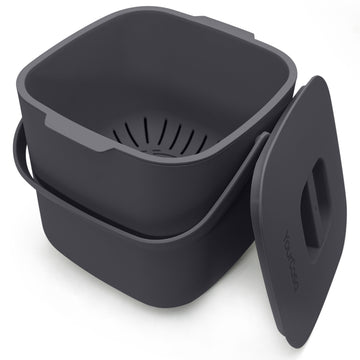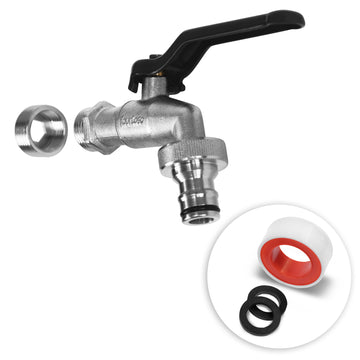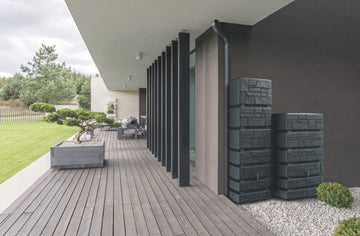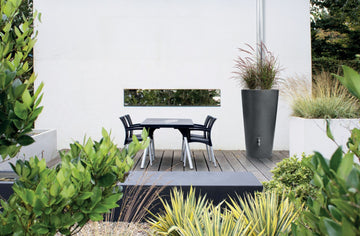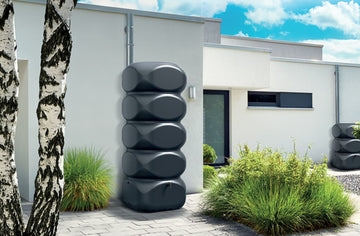
Collecting rainwater is practical and good for both the environment and your wallet. Anyone with their own garden can easily start doing it. Even though collecting rainwater is actually very easy, there are a few things that can go wrong.
One of these things is barrel overflow . While this may seem like a minor inconvenience at first glance, it can cause a whole host of problems. Excess water can flood the garden, suffocate plant roots and damage the soil structure. In the worst case scenario, it can also cause moisture damage to the house.
In this article, you will learn what measures you can take to prevent an overflowing rain barrel while still taking full advantage of the benefits of rainwater harvesting. From simple solutions such as installing an overflow guard to creative methods of storing and using water, we offer you valuable tips and instructions for optimal rainwater harvesting in your garden.
What can I do if the rain barrel overflows? If your rain barrel overflows regularly, there are several effective measures you can take. Install an overflow protection device to safely drain excess water. Use additional water by diverting it into additional containers or using it directly to water your garden. A rain collector with integrated overflow protection prevents overflow from the start. Regularly checking and cleaning the rain barrel can also help prevent blockages. This way you can ensure that the rainwater is used optimally and damage to the house and garden is avoided.
What happens if the rain barrel overflows?
An overflowing rain barrel can lead to a whole range of problems that can affect both the garden and the building. How quickly a rain barrel fills up depends on factors such as the local rainfall and the roof area. The result of a barrel that is too small: the rain barrel overflows.
In the garden, excess water can cause erosion by removing the top layer of soil, exposing and damaging plant roots. Waterlogging is another common problem that occurs when soil remains permanently wet. This can cause plant roots to suffocate and rot - and that's not good for the health of the garden at all.
Your house itself can also be damaged by an overflowing rain barrel. If the water flows uncontrollably along the foundations and walls, it can penetrate the masonry and cause moisture damage . This moisture can lead to the formation of mold, which not only endangers the building structure, but also your health and that of your family. If such damage is not repaired quickly, it can lead to significant repair costs in the long term and reduce the value of the property.
In some regions, there are also legal regulations or municipal ordinances that affect the use of stormwater systems. These regulations may require measures to prevent overflows and safely drain excess water. Check the local regulations in your community to avoid potential legal consequences and to ensure that your stormwater management is compliant.
By the way: a full rain barrel in winter can cause damage such as cracks in the barrel. You should therefore empty it before the first frost.

How can I make good use of the overflow water?
You can use the overflow water from your rain barrel in a variety of ways to supply both your garden and other areas of your property.
- Watering garden plants and lawns: One of the simplest and most effective methods is to use excess water to water garden plants and lawns. By directing the water directly to beds and lawns, you can ensure that your plants are adequately supplied even during dry periods while conserving water resources.
- Storage tanks or cisterns: Another option is to direct the overflow water into additional storage tanks or cisterns. These tanks can be placed in different places in the garden and provide an additional water reserve for times when there is less rain. Tanks are much less complicated to install than underground cisterns. By installing a distribution system, you can use the collected water flexibly and efficiently.
- Fill ponds or pools: You could use the overflow water to fill ponds or pools, for example, without using precious and expensive drinking water. This is not only an environmentally friendly method of supplying water, but also helps regulate the water level in ponds and supports the ecosystem. In the case of pools, rainwater can be used as a supplement to the usual filling, thus reducing fresh water consumption.
What can overflowing rainwater be used for spontaneously?
If you don't have overflow protection or extra tanks, you can also use overflowing rainwater spontaneously to prevent it from seeping away. You have the following options:
- Cleaning garden furniture or vehicles: One of the easiest ways is to clean garden furniture or vehicles. With a bucket and a sponge, you can quickly collect the excess water and use it for these purposes. Since rainwater is softer than tap water, it also leaves fewer limescale stains and is therefore gentler on the surfaces.
- Cooling plants: In hot summer months, excess water can be used to cool plants. Particularly sensitive plants benefit from additional cooling achieved by spraying with rainwater. This helps to reduce the stress caused by high temperatures and keep the plants healthy.
- Filling watering cans and mobile water containers: Another practical use for overflowing rainwater is the quick filling of watering cans and mobile water containers. These can be distributed flexibly around the garden to always have a water source on hand for spontaneous watering work. This is particularly useful when individual plants or beds need additional water at short notice.
To ensure that you can use overflowing water quickly and spontaneously , we recommend strategically placing buckets or water barrels near the overflow point. This way, you can collect the excess water directly and use it without delay.
How does an infiltration system work?
An infiltration system is a system that collects excess rainwater and drains it into the ground in a controlled manner , rather than letting it flow away uncontrollably. This is particularly helpful for overflowing rain barrels by efficiently managing the excess water and thus preventing damage to the garden and house. Such a system usually consists of a storage and an infiltration area, which are connected to a drainage system. The water flows from the storage to the infiltration area, where it slowly penetrates the soil and enriches the groundwater.
The advantages of an infiltration system are many . It helps prevent flooding in the garden and reduces the risk of erosion and waterlogging. It also helps to improve water quality by filtering pollutants in the soil before the water reaches the groundwater. The infiltration system also promotes the sustainable use of rainwater and relieves the burden on the urban sewer system.
To install a simple infiltration system yourself , you first need a suitable location that is not too close to the house or other buildings. Dig a sufficiently large hole there that will serve as an infiltration area. Fill the hole with a layer of gravel or coarse sand that will serve as a filter and drainage. Connect your rain barrel to the infiltration area using a pipe or drainage line . Make sure that the pipe is slightly inclined so that the water can drain away easily. Cover the infiltration area with a layer of soil and, if necessary, plant plants that can also absorb the water.
| Advantages of an infiltration system | Disadvantages without infiltration system |
| Preventing flooding | Damage to the ground and the building |
| Reduces the risk of erosion and waterlogging | Erosion and waterlogging damage the garden |
| Improving water quality | Unfiltered water can spread pollutants |
| Promoting sustainable rainwater use | Waste of rainwater |
| Relieves the urban sewer system | Load on the urban sewer system and possible backflow problems |

How do I avoid wasting natural resources?
Using rainwater to water your garden offers numerous advantages over using tap water. Rainwater is not only free, but also softer and free of chemical additives that are often found in tap water. This is particularly beneficial for plants, as it allows them to be watered in a more natural and gentle way. Using rainwater also conserves drinking water resources and reduces water bills .
There are several practical measures you can take to reduce water consumption in your home and garden . One of the simplest methods is to install water-saving fittings and devices such as flow restrictors on faucets and showerheads. In the garden, layers of mulch around plants can help retain soil moisture and reduce the need for frequent watering. You should also make sure to water plants in the early morning or late evening to minimize evaporation losses. This is especially true on hot summer days.
Proper care and use of rain barrels can also save money in the long term . Regular cleaning of your rain barrel prevents blockages and algae build-up, which extends the life of the barrel. Installing an overflow protection ensures that excess water is safely drained away and no damage is caused to the house and garden. By using additional storage tanks, excess water can be stored and used when needed, further reducing dependence on expensive tap water.
conclusion
Using rainwater in the garden and at home offers so many advantages that it is difficult to list and explain them all in one article. Problems such as the rain barrel overflowing and the associated damage can be easily avoided with a few tricks.
Install a simple overflow protection to use the excess water for other purposes or build a simple infiltration system so that it does not cause damage to the garden or house. YourCasa offers a simple solution with the Downpipe70 rain collector .
If you are looking for more tips on using rainwater or are already excited about it, you should visit YourCasa and take a look at our rain barrels and our rain barrel accessories .

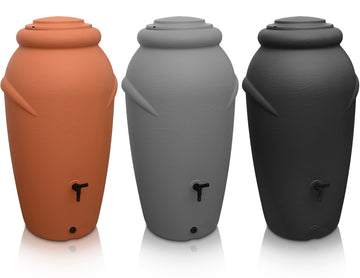
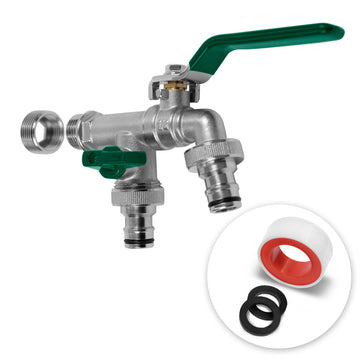
![Drei hohe YourCasa Regentonne 240 Liter [Wellen-Design] - Frostsicher & UV-beständige Gartentöpfe in den Farben Schwarz, Grau und Terrakotta, jeweils mit Drainagesystem für nachhaltige Bewässerung.](http://yourcasa.de/cdn/shop/files/ohnelogo_b8aeecac-557e-4106-a999-e77dcd160209.jpg?v=1707130230&width=360)
